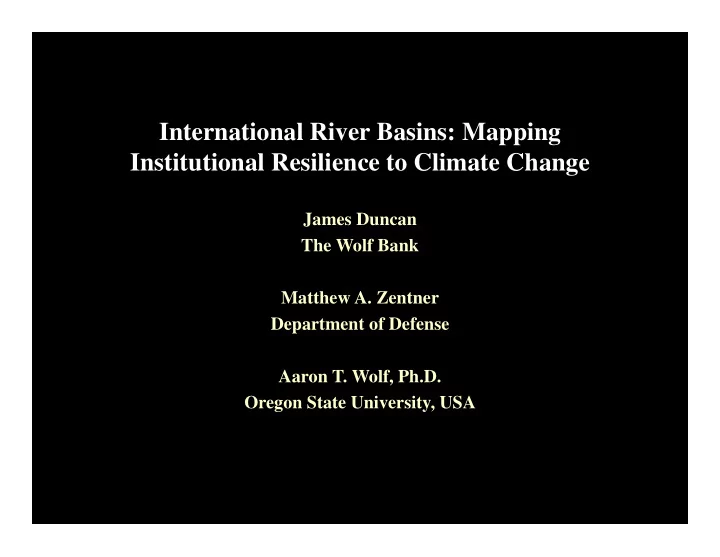

International River Basins: Mapping Institutional Resilience to Climate Change James Duncan The Wolf Bank Matthew A. Zentner Department of Defense Aaron T. Wolf, Ph.D. Oregon State University, USA
What is International Water Management?? What changes when a border is present? What capacity do we need to address the change?
Security/Economic Hostilities War Tensions Alliance (e.g. sanctions) Disputes Acute (Violent) Conflict Cooperation Neutral Relations
The Transboundary Freshwater Dispute Database A Project of Oregon State University Department of Geosciences and the Northwest Alliance for Computational Science • Reference to 3,600 water-related treaties (805-1997) •Full-text of 688 treaties and 40 US compacts, entered in computer database •Detailed negotiating notes (primary or secondary) from fourteen case-studies of water conflict resolution •Annotated bibliography of “State of the Art” of water dispute resolution literature •News files on cases of acute water-related disputes •Indigenous methods of water dispute resolution
Number of Events by BAR Scale 1948-2008 682 700 600 500 420 400 334 300 276 242 227 200 164 122 100 68 21 17 7 6 0 0 0 -7 -6 -5 -4 -3 -2 -1 0 1 2 3 4 5 6 7 Increasing Conflict Increasing Cooperation Source: De Stefano, L., P. Edwards, L. de Silva and A. T. Wolf 2010. “Tracking Cooperation and Conflict in International Basins: Historic and Recent Trends.” Water Policy. Vol 12 No 6 pp 871–884. Adapted with permission of the authors.
Water Myths and Water Facts Causes of conflict include: -- Climate -- Water stress -- Population -- Level of development -- Dependence on hydropower -- Dams or development per se -- “Creeping” changes: • general degradation of quality • climate change induced hydrologic variability
BASINS AT RISK: Working Hypothesis “The likelihood of conflict rises as the rate of change within the basin exceeds the institutional capacity to absorb that change.” What are indicators ? Sudden physical changes or lower institutional capacity are more conducive to disputes: 1) Uncoordinated development: a major project in the absence of a treaty or commission 2) “Internationalized basins” 3) General animosity
Basin-Country Units (BCUs)
Present Runoff Variability Regime (1961-1990) Present
TFDD-IWMI Treaty Update Africa Asia Europe N. S. TOTAL America America # TB BASINS 63 60 69 46 38 276 # Multi ‐ lateral 30 22 23 3 8 86 Basins % w/at least 1 30.2 30.0 55.1 63.0 23.7 40.9 treaty % Bilateral 9.1 15.8 39.1 60.5 16.7 30.5 Basins w/at least 1 treaty % BCU’s w/at 37.3 30.1 58.9 61.1 29.0 43.2 least 1 treaty % TB Area w/at 74.4 43.4 47.5 98.5 86.1 68.5 least 1 treaty % TB Population 78.8 78.0 71.2 94.5 85.2 78.6 covered by at least 1 treaty
Criterion Score At least one water treaty 0/1 At least one treaty with an allocation 0/1 mechanism At least one treaty with a variability 0/1 management mechanism At least one treaty with a conflict 0/1 resolution mechanism At least one river basin organization 0/1 present Total possible treaty/RBO score for each 0 to 5 basin-country unit
Vulnerability ] Low ] Medium ] High
Where are they in Mekong Basin? (1) Reservoirs: • China dams in Lancang; • Laos dams in tributaries; • Vietnam dams in the Central Highlands; • Cambodia dams in tributaries; • LMB mainstream giant dams??? Flood protection and control structures and road system in Flood Plain
Recommend
More recommend